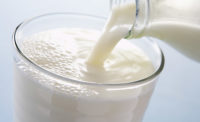Understanding the fat, sugar and calories in cow’s milk to make the best choices
Decoding dairy

What type of milk is best? Is fat in or out, and what about sugar? These are questions swirling in the minds of many consumers. By providing people with information about the fat, sugar and calories in cow’s milk options in the marketplace, the dairy community can help people choose the right dairy foods to meet their needs.
Let’s look at where we stand in the United States when it comes to meeting dairy recommendations as part of healthy and sustainable eating patterns. On average, Americans get about 1.7 of the three daily servings recommended for those ages 9 and older by the Dietary Guidelines for Americans (DGA). There is an opportunity to close this gap.
Dairy foods such as milk are foundational foods in healthy eating patterns, which is one reason they have their own food group. They contribute important nutrients people don’t get enough of, including calcium, vitamin D and potassium. Regardless of type — low-fat, whole, lactose-free, chocolate — all milk provides nine essential nutrients, including protein, calcium, phosphorus and vitamins A, D, B12, riboflavin (B2), niacin (B3) and pantothenic acid (B5). Thus, milk helps contribute to the nutrient-richness of the overall diet.
Additionally, dairy food consumption — regardless of fat level — is linked to bone health, especially in children and adolescents. Healthy eating patterns that include low-fat or fat-free dairy foods are associated with reduced risk of cardiovascular disease and type 2 diabetes.
Fat and calories
The main difference between whole and fat-free milk is the fat level, which affects the total calories; otherwise, the nutrition in milk is the same at all fat levels. Each gram of fat provides 9 calories, so fat-free milk has the fewest calories at 80 per 8-ounce serving. Whole milk has 8 grams of fat and provides 150 calories per 8-ounce serving.
The DGA recommends low-fat and fat-free milk as part of healthy eating plans that are lower in saturated fat and calories. However, it is possible to include full-fat or reduced-fat dairy foods within an overall healthy eating plan if saturated fat does not exceed 10% of the total calories recommended by the DGA.
Sugar and calories
All sugars fall into the carbohydrates category. White milk contains the naturally occurring sugar lactose, which is not considered to be added sugar. White unflavored milk, regardless of fat level, will provide about 12 grams of carbohydrates per 8-ounce serving.
Flavored milk has the same nine essential nutrients as white milk, just with added sugar. The amount of added sugar and calories will depend on the variety.
The majority of added sugars consumed in the U.S. diet do not come from flavored milk; in fact, for children 2-18 years old, flavored milk contributes only 4% of added sugars, on average. Because of dairy community innovation, the average flavored milk offered in schools contains about 7.5 grams of added sugar for about 25 additional calories, which represents about 45 fewer calories and 55% less added sugar than what could be found a decade ago.
The DGA notes that small amounts of added sugars can be part of healthy eating patterns to increase the palatability and appeal of nutrient-rich foods such as milk and whole grains. The DGA recommends that added sugar should make up no more than 10% of total recommended calories.
Dairy foods help nourish life and can benefit all ages — from 1 to 100 — because they provide essential nutrients such as protein, calcium and B vitamins that our bodies never stop needing.
Looking for a reprint of this article?
From high-res PDFs to custom plaques, order your copy today!









